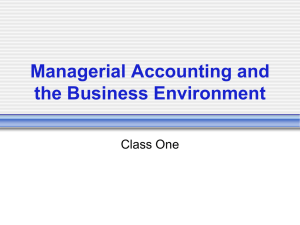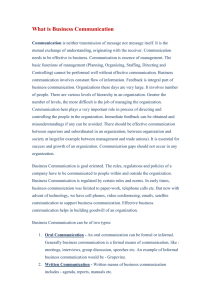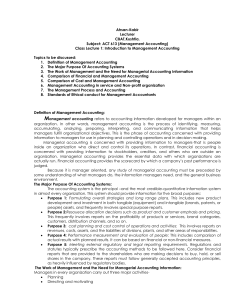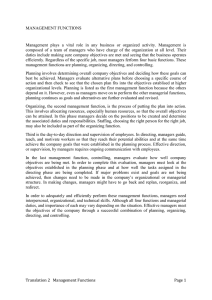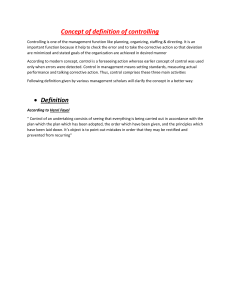Management Accounting: Definition, Importance, and Techniques
advertisement
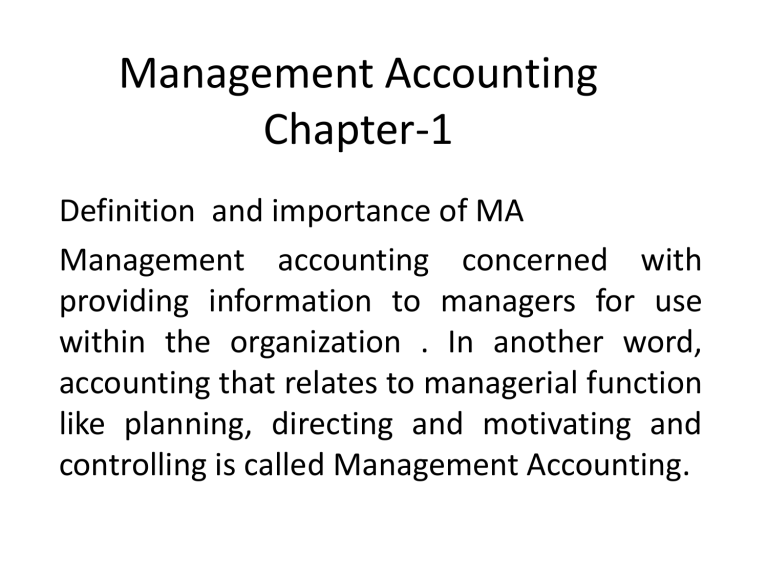
Management Accounting Chapter-1 Definition and importance of MA Management accounting concerned with providing information to managers for use within the organization . In another word, accounting that relates to managerial function like planning, directing and motivating and controlling is called Management Accounting. Characteristic of Management Accounting • Management oriented Accounting • Relates with managerial function . i.e planning, direction and motivation , and controlling in order to increase efficiency. • It provides information for internal users of an organization. • It can assist the top level management and other departments in the formation of policy and control. Work of Management and need for MA information Planning Directing and Motivating Controlling Planning Identify alternatives. Select alternative that does the best job of furthering organization’s objectives. Develop budgets to guide progress toward the selected alternative. Directing and Motivating Directing and motivating involves managing dayto-day activities to keep the organization running smoothly. – Employee work assignments. – Routine problem solving. – Conflict resolution. – Effective communications. Controlling The control function ensures that plans are being followed. Feedback in the form of performance reports that compare actual results with the budget are an essential part of the control function. Planning and Control Cycle Formulating long-and short-term plans (Planning) Comparing actual to planned performance (Controlling) Decision Making Measuring performance (Controlling) Begin Implementing plans (Directing and Motivating) Comparison of Financial and Managerial Accounting Financial Accounting Managerial Accounting External persons who make financial decisions Managers who plan for and control an organization Historical perspective Future emphasis 3. Verifiability versus relevance Emphasis on verifiability Emphasis on relevance for planning and control 4. Precision versus timeliness Emphasis on precision Emphasis on timeliness 5. Subject Primary focus is on the whole organization Focuses on segments of an organization 6. GAAP Must follow GAAP and prescribed formats Need not follow GAAP or any prescribed format Mandatory for external reports Not Mandatory 1. Users 2. Time focus 7. Requirement The Changing Business Environment and Management Accounting • • • • • • Just-in-time production Total quality management Process reengineering Theory of constraints International competition E-commerce Business environment changes in the past twenty years Process Management • A business process is a series of steps that are followed in order to carry out some task in a business • The different approaches to managing and improving business process are : -Lean Production -Theory of Constraint -Six sigma Lean Thinking Model • It is a five step management approach that organizes resources such as people and machines around the flow of business processes and that pulls units through these process in response to the customers. • The lean thinking model Step-1.Identify value in specific products Step-2.Identify business process that delivers value Step-3.Organize work arrangements around the flow of the business process Step-4.Create a pull system that responds customers orders Step-5.Continuously pursue perfection in the business process. Just-in-Time (JIT) Systems Receive customer orders. Complete products just in time to ship customers. Schedule production. Receive materials just in time for production. Complete parts just in time for assembly into products. JIT Consequences Improved plant layout Reduced setup time Zero production defects Flexible workforce JIT purchasing Fewer, but more ultra reliable suppliers. Frequent JIT deliveries in small lots. Defect-free supplier deliveries. Benefits of a JIT System Reduced inventory costs Freed-up funds Greater customer satisfaction Higher quality products Increased throughput More rapid response to customer orders Total Quality Management (TQM) TQM improves productivity by encouraging the use of fact and analysis for decision making and if properly implemented, avoids counter-productive organizational infighting. Continuous Improvement Systematic problem solving using tools such as benchmarking is Process Reengineering A business process is diagrammed in detail. Every step in the business process must be justified. Anticipated results: Process is simplified. Process is completed in less time. Costs are reduced. Opportunities for errors are reduced. The process is redesigned to eliminate all non-value-added activities Process Reengineering versus TQM Process Reengineering • Radically overhauls existing processes. • Likely to be imposed from above and to use outside consultants. Total Quality Management • Tweaks existing processes to realize gradual improvements. • Uses a team approach involving people who work directly in the process. Six Sigma Six sigma is a process improvement method that relies on customer feedback and fact based data gathering and analyst techniques to drive process improvements • Define • Measure • Analyze • Improve • Control Establish the scope and purpose of the projects Diagram the flow of the current process Establish the customer’s requirement for the process Gather baseline performance data related to the existing process Narrow the scope of the project to the most important problems Identify the root cause of the problems identified in the measure stage Develop , evaluate , and implement solution to the problems Ensure that problems remain fixed. Seek to improve the new method over time. Theory of Constraints A constraint (also called a bottleneck) is anything that prevents you from getting more of what you want. The constraint in a system is determined by the step that has the smallest capacity. Theory of Constraints Only actions that strengthen the weakest link in the “chain” improve the process. 2. Allow the weakest link to set the tempo. 3. Focus on improving the weakest link. 1. Identify the weakest link. 4. Recognize that the weakest link is no longer so. Surbanes Oxley Act


